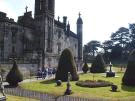The Towers: Alton Towers
Alton Towers, being the house itself, has had a relatively
short life, although the surrounding landscape would be totally
unrecognisable if someone from the early 1800's arrived in
our time. It is unclear when the house was originally built,
although it is accepted that it certainly existed in 1731,
as an engraving of Alton Castle at this time, clearly shows
what was then known as Alveton Lodge in the background. Another
picture from 1800, again shows Alveton Lodge, some of which
is still standing today.
The house was part of the estate of the Earls of Shrewsbury,
and Alveton Lodge was regarded as an occasional residence
for the family, until the late 18th century, when Charles,
the 15th Earl, who decided to turn Alveton Lodge into what
we see there today. In the following years, thousands of trees,
shrubs and flowers were planted in the dry valley to the east
of the house, and water diverted from a spring to create the
lakes and ponds in the gardens. Today, we see the result of
all the work that went into the park in it's infancy. The
Earl, obviously had a long term vision for the estate.
Over the years, the house passed down the family, with John
Talbot continuing with his Uncles plans. A.W. Pugin was hired,
along with other architects and craftsmen to create what would
become the most outstanding example of gothic architecture
in the United Kingdom. In the early 1900's however, the house
began it's demise, when a lack of funds prevented the family
from taking care of all the maintenance on the house, until
it was sold to a group of business men in 1924. The house
then fell into disrepair. The rooms that were kept well maintained
were now used as cafe areas for the people who flocked to
the park to enjoy the gardens and other entertainments.
This continued until the outbreak of World War 2, when the
house was requisitioned by the army, and used as a cadet training
facility. Again, the house received little or no work, and
continued to decay until 1951 when it was handed back to the
Alton Towers Company. At this time of the century, following
a war, metals and building materials were scarce, and so the
house finally met its doom. Everything that could be stripped
and sold, was. All the ornate woodwork was removed from the
walls and sold, along with anything else of value. It is said
that people still living in the village remember lorries passing
by every day loaded with timber.
It wasn't until the early 1970's that the house received
an owner a little more sympathetic. The house was granted
Grade II Listed Building status, and work began on restoring
parts of the house, that could be restored. This included
creating reinforced concrete floors, roofing, and the great
wooden roof of the dining hall was restored to it's former
glory. Currently owned by the Tussauds group, the house is
still undergoing restoration work, although it will be several
years yet before visitors can wander even further into the
depths of history at Alton Towers.
CONTACT ADDRESSES:
Alton Towers
Staffordshire, ST10 4DB
UK
Tel: (08705) 204 060
Fax: (01538) 704 097
www.altontowerspark.info
|